Hassani S. Mathematical Methods: For Students of Physics and Related Fields
Подождите немного. Документ загружается.

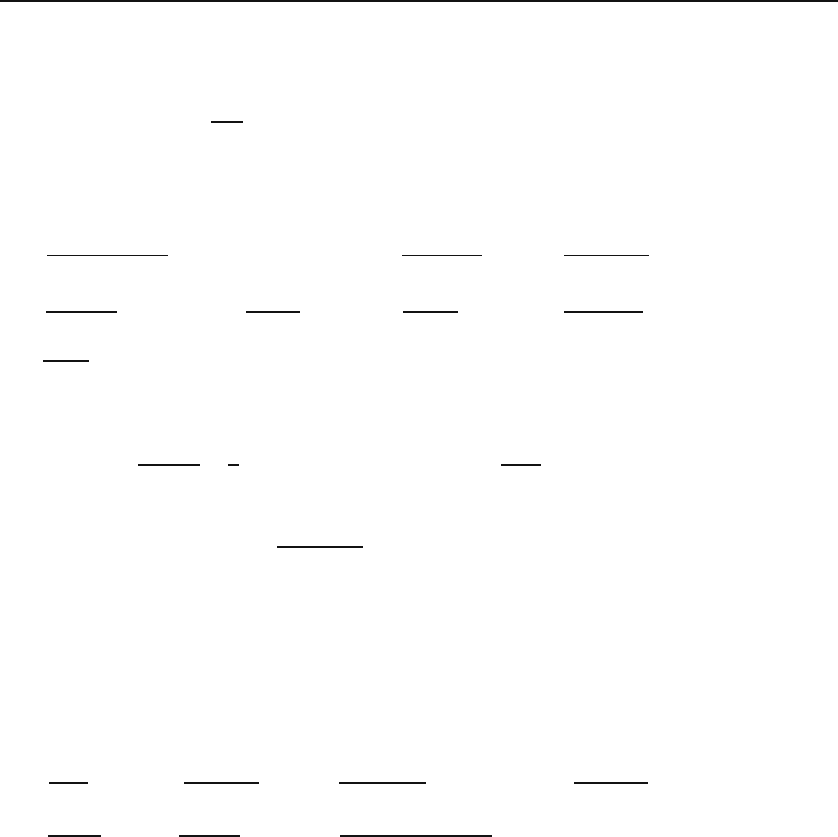
20.3 Problems 523
20.4. Find the Taylor expansion of 1/z
2
for points inside the circle |z−2| < 2.
20.5. Use mathematical induction to show that
d
n
dz
n
(1 + z)
−1
z=0
=(−1)
n
n!.
20.6. Find the (unique) Laurent expansion of each of the following functions
in each of its regions of analyticity:
(a)
1
(z − 2)(z −3)
. (b) z cos(z
2
). (c)
1
z
2
(1 −z)
. (d)
sinh z − z
z
4
.
(e)
1
(1 −z)
3
. (f)
1
z
2
− 1
. (g)
z
2
− 4
z
2
− 9
. (h)
1
(z
2
− 1)
2
.
(i)
z
z − 1
.
20.7. Show that the following functions are entire:
(a) f (z)=
⎧
⎨
⎩
e
2z
− 1
z
2
−
2
z
for z =0,
2forz =0.
(b) f (z)=
0
sin z
z
for z =0,
1forz =0.
(c) f(z)=
⎧
⎨
⎩
cos z
z
2
− π
2
/4
for z = ±π/2,
−1/π for z = ±π/2.
20.8. Obtain the first few nonzero terms of the Laurent-series expansion of
each of the following functions about the origin by approximating the denomi-
nator by a polynomial and using the technique of long division of polynomials.
Also find the integral of the function along a small simple closed contour en-
circling the origin.
(a)
1
sin z
. (b)
1
1 − cos z
. (c)
z
1 − cosh z
. (d)
z
2
z − sin z
.
(e)
1
e
z
− 1
. (f)
1
z
2
sin z
. (g)
z
4
6z + z
3
− 6sinhz
.
20.9. Obtain the Laurent-series expansion of f (z)=sinhz/z
3
about the
origin.
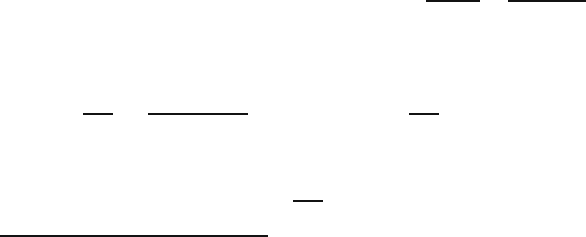
Chapter 21
Calculus of Residues
One of the most powerful tools made available by complex analysis is the
theory of residues, which makes possible the routine evaluation of certain real
definite integrals that are impossible to calculate otherwise. Example 20.2.6
showed a situation in which an integral was related to expansion coefficients
of Laurent series. Here we will develop a systematic way of evaluating both
real and complex integrals using the same idea.
Recall that a singular point z
0
of f(z)isapointatwhichf fails to be
analytic. If, in addition, there is some neighborhood of z
0
in which f is
analytic at every point (except, of course, at z
0
itself), then z
0
is called an
isolated singularity of f. All singularities we have encountered so far have
isolated singularity
been isolated singularities. Although singularities that are not isolated also
exist, we shall not discuss them in this book.
21.1 The Residue
Let z
0
be an isolated singularity of f . Then there exists an r>0 such that,
within the “annular” region 0 < |z − z
0
| <r, the function f has the Laurent
expansion
1
f(z)=
∞
n=−∞
a
n
(z − z
0
)
n
≡
∞
n=0
a
n
(z − z
0
)
n
+
b
1
z − z
0
+
b
2
(z − z
0
)
2
+ ··· ,
where
a
n
=
1
2πi
2
C
f(ξ) dξ
(ξ − z
0
)
n+1
and b
n
=
1
2πi
2
C
f(ξ)(ξ − z
0
)
n−1
dξ.
In particular,
b
1
=
1
2πi
2
C
f(ξ) dξ, (21.1)
1
We are using b
n
for a
−n
.
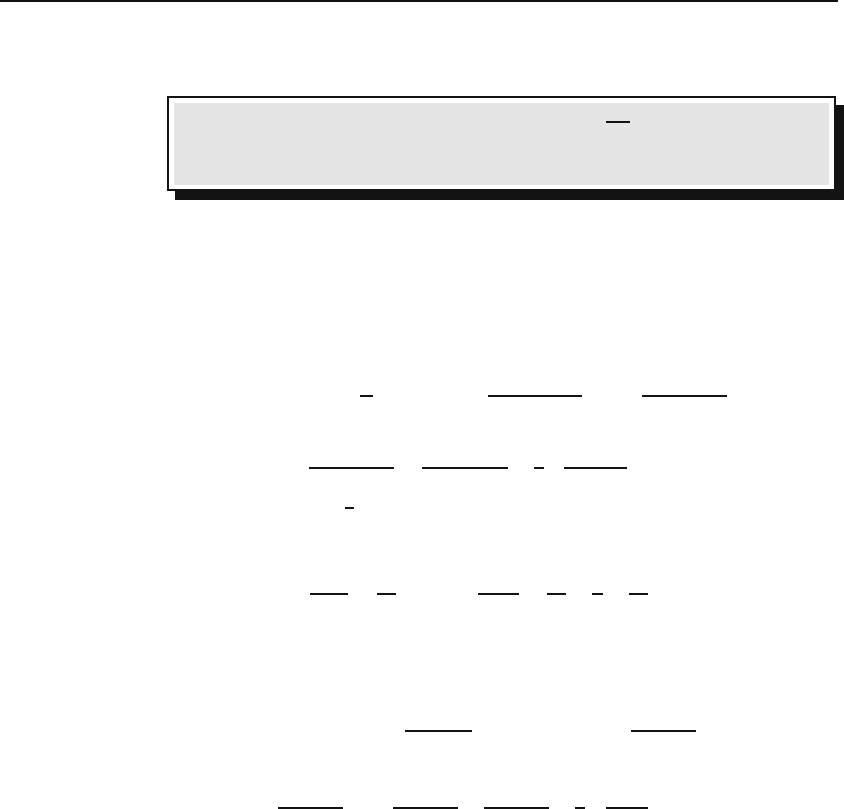
526 Calculus of Residues
where C is any simple closed contour around z
0
, traversed in the positive
sense, on and interior to which f is analytic except at the point z
0
itself.residue defined
Box 21.1.1. The complex number b
1
,whichis
1
2πi
times the integral of
f(z) along the contour, is called the residue of f at the isolated singular
point z
0
.
It is important to note that the residue is independent of the contour C as
long as z
0
is the only isolated singular point within C.
Example 21.1.1.
We want to evaluate the integral
E
C
sin zdz/(z − π/2)
3
where
C is any simple closed contour having z = π/2 as an interior point.
To evaluate the integral we expand around z = π/2 and use Equation (21.1).
We note that
sin z =cos
z −
π
2
=
∞
n=0
(−1)
n
(z − π/2)
2n
(2n)!
=1−
(z − π/2)
2
2
+ ···
so
sin z
(z − π/2)
3
=
1
(z − π/2)
3
−
1
2
1
z − π/2
+ ··· .
It follows that b
1
= −
1
2
; therefore,
E
C
sin zdz/(z − π/2)
3
=2πib
1
= −iπ.
Example 21.1.2. The integral
E
C
cos zdz/z
2
,whereC is the circle |z| =1,is
zero because
cos z
z
2
=
1
z
2
∞
n=0
(−1)
n
z
2n
(2n)!
=
1
z
2
−
1
2
+
z
2
4!
+ ···
yields b
1
=0(no1/z term in the Laurent expansion). Therefore, by Equation (21.1)
the integral must vanish.
When C is the circle |z| =2,
E
C
e
z
dz/(z − 1)
3
= iπe because
e
z
= ee
z−1
= e
∞
n=0
(z −1)
n
n!
= e
1+(z − 1) +
(z − 1)
2
2!
+ ···
and
e
z
(z − 1)
3
= e
1
(z − 1)
3
+
1
(z −1)
2
+
1
2
1
z −1
+ ···
.
Thus, b
1
= e/2, and the integral is 2πib
1
= iπe.
We use the notation Res[f(z
0
)] to denote the residue of f at the isolated
singular point z
0
. Equation (21.1) can then be written as
2
C
f(z) dz =2πi Res[f(z
0
)].
What if there are several isolated singular points within the simple closed
contour C?LetC
k
be the positively traversed circle around z
k
shown in
Figure 21.1. Then the Cauchy–Goursat theorem yields
0=
2
C
f(z) dz =
2
circles
f(z) dz +
2
parallel
lines
f(z) dz +
2
C
f(z) dz,
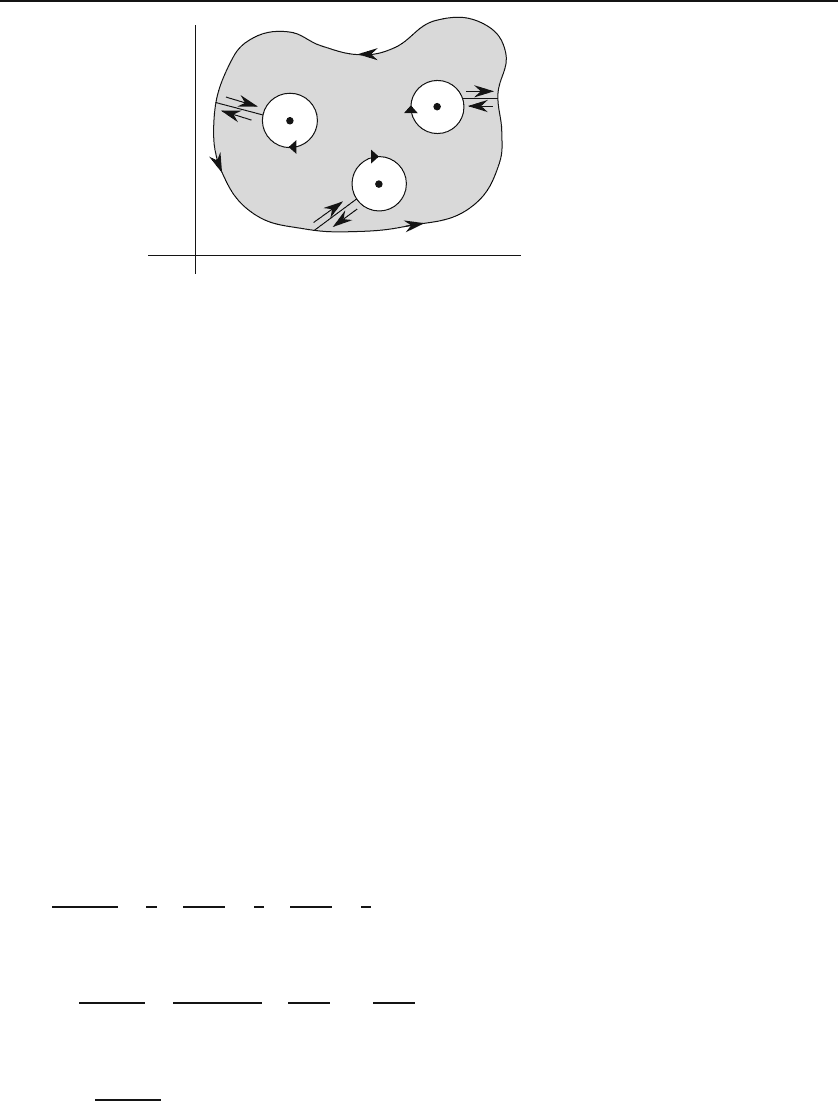
21.1 The Residue 527
z
1
z
2
z
m
C
1
C
2
C
m
Figure 21.1: Singularities are avoided by going around them.
where C
is the union of all contours inside which union there are no singu-
larities. The contributions of the parallel lines cancel out, and we obtain
2
C
f(z) dz = −
m
k=1
2
C
k
f(z) dz =
m
k=1
2πi Res[f(z
k
)],
where in the last step the definition of residue at z
k
has been used. The minus
sign disappears in the final result because the sense of C
k
, while positive for
the shaded region of Figure 21.1, is negative for the interior of C
k
because
this interior is to our right as we traverse C
k
in the direction indicated. We
thus have
Theorem 21.1.3. (The Residue Theorem).LetC be a positively inte-
grated simple closed contour within and on which a function f is analytic
except at a finite number of isolated singular points z
1
,z
2
,...,z
m
interior to
C.Then
2
C
f(z) dz =2πi
m
k=1
Res[f(z
k
)]. (21.2)
Example 21.1.4.
Let us evaluate the integral
E
C
(2z − 3) dz/[z(z − 1)] where C
is the circle |z| = 2. There are two isolated singularities in C, z
1
=0andz
2
=1.
To find Res[f(z
1
)], we expand around the origin using Equation (20.2):
2z − 3
z(z − 1)
=
3
z
−
1
z − 1
=
3
z
+
1
1 − z
=
3
z
+1+z + ··· for |z| < 1.
This gives Res[f(z
1
)] = 3. Similarly, expanding around z =1gives
2z − 3
z(z − 1)
=
3
(z − 1) + 1
−
1
z − 1
= −
1
z −1
+3
∞
n=0
(−1)
n
(z − 1)
n
which yields Res[f(z
2
)] = −1. Thus,
2
C
2z − 3
z(z − 1)
dz =2πi{Res[f(z
1
)] + Res[f(z
2
)]} =2πi(3 − 1) = 4πi.

528 Calculus of Residues
Let f(z) have an isolated singularity at z
0
. Then there exist a real number
r>0 and an annular region 0 < |z − z
0
| <rsuch that f can be represented
by the Laurent series
f(z)=
∞
n=0
a
n
(z − z
0
)
n
+
∞
n=1
b
n
(z − z
0
)
n
. (21.3)
The second sum in Equation (21.3), involving negative powers of (z − z
0
), is
called the principal part of f at z
0
. The principal part is used to classifyprincipal part of a
function
isolated singularities. We consider two cases:
(a) If b
n
=0foralln ≥ 1, z
0
is called a removable singular point of f.
removable singular
point
In this case, the Laurent series contains only nonnegative powers of (z − z
0
),
and setting f(z
0
)=a
0
makes the function analytic at z
0
. For example, the
function f (z)=(e
z
− 1 − z)/z
2
, which is indeterminate at z = 0, becomes
entire if we set f(0) = 1/2, because its Laurent series
f(z)=
1
2
+
z
3!
+
z
2
4!
+ ···
has no negative power.
(b) If b
n
=0foralln>mand b
m
=0,z
0
is called a pole of order m.Inpoles defined
this case, the expansion takes the form
f(z)=
∞
n=0
a
n
(z − z
0
)
n
+
b
1
z − z
0
+ ···+
b
m
(z − z
0
)
m
for 0 < |z − z
0
| <r. In particular, if m =1,z
0
is called a simple pole.simple pole
Example 21.1.5. Let us consider some examples of poles of various orders.
(a) The function (z
2
−3z +5)/(z −1) has a Laurent series around z = 1 containing
only three terms: (z
2
− 3z +5)/(z − 1) = −1+(z − 1) + 3/(z − 1). Thus, it has a
simple pole at z = 1, with a residue of 3.
(b) The function sin z/z
6
has a Laurent series
sin z
z
6
=
1
z
6
∞
n=0
(−1)
n
z
2n+1
(2n +1)!
=
1
z
5
−
1
6z
3
+
1
(5!)z
−
z
7!
+ ···
about z = 0. The principal part has three terms. The pole, at z =0,isoforder5,
and the function has a residue of 1/120 at z =0.
(c) The function (z
2
−5z +6)/(z −2) has a removable singularity at z =2,because
z
2
− 5z +6
z − 2
=
(z −2)(z − 3)
z − 2
= z − 3=−1+(z − 2)
and b
n
=0foralln.
The type of isolated singularity that is most important in applications is
of the second type—poles. For a function that has a pole of order m at z
0
,
the calculation of residues is routine. Such a calculation, in turn, enables us

21.2 Integrals of Rational Functions 529
to evaluate many integrals effortlessly. How do we calculate the residue of a
function f having a pole of order m at z
0
?
It is clear that if f has a pole of order m,theng(z) defined by g(z) ≡
(z − z
0
)
m
f(z)isanalyticatz
0
. Thus, for any simple closed contour C that
contains z
0
but no other singular point of f,wehave
Res[f(z
0
)] =
1
2πi
2
C
f(z) dz =
1
2πi
2
C
g(z) dz
(z − z
0
)
m
=
g
(m−1)
(z
0
)
(m −1)!
,
where we used Equation (19.10). In terms of f this yields
2
Res[f(z
0
)] =
1
(m − 1)!
lim
z→z
0
d
m−1
dz
m−1
[(z − z
0
)
m
f(z)]. (21.4)
For the special, but important, case of a simple pole, we obtain
Res[f(z
0
)] = lim
z→z
0
[(z − z
0
)f(z)]. (21.5)
The most widespread application of residues occurs in the evaluation of
application of the
residue theorem in
evaluating definite
integrals
real definite integrals. It is possible to “complexify” certain real definite in-
tegrals and relate them to contour integrations in the complex plane. What
is typically involved is the addition of a number of semicircles to the real
integral such that it becomes a closed contour integral whose value can be
determined by the residue theorem. One then takes the limit of the contour
integral when the radii of the semicircles go to infinity or zero. In this limit
the contributions from the semicircles should vanish for the method to work.
In that case, one recovers the real integral. There are three types of integrals
most commonly encountered. We discuss these separately below. In all cases
we assume that the contribution of the semicircles will vanish in the limit.
21.2 Integrals of Rational Functions
The first type of integral we can evaluate using the residue theorem is of the
form
I
1
=
#
∞
−∞
p(x)
q(x)
dx,
where p(x)andq(x) are real polynomials, and q(x) =0foranyrealx.We
can then write
I
1
= lim
R→∞
#
R
−R
p(x)
q(x)
dx = lim
R→∞
#
C
x
p(z)
q(z)
dz,
where C
x
is the (open) contour lying on the real axis from −R to +R.We
now close that contour by adding to it the semicircle of radius R [see Fig-
ure 21.2(a)]. This will not affect the value of the integral because, by our
2
The limit is taken because in many cases the mere substitution of z
0
may result in an
indeterminate form.
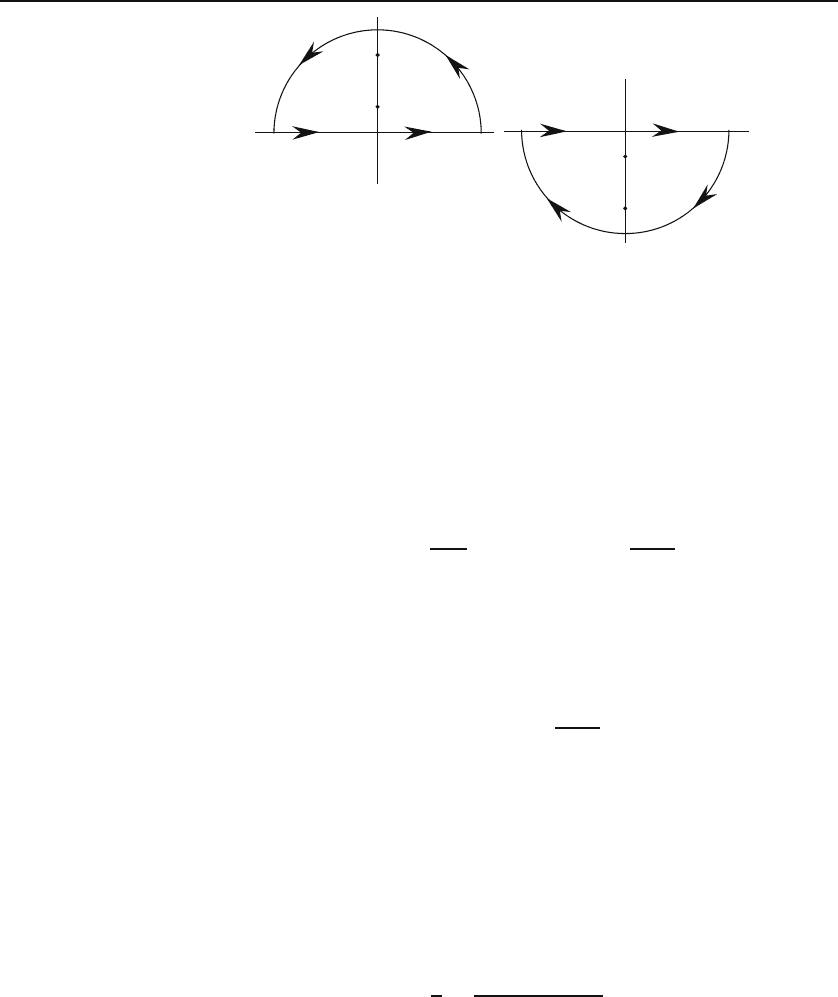
530 Calculus of Residues
3i
i
−RR
(a)
−i
−3i
−R
R
(b)
Figure 21.2: (a) The large semicircle is chosen in the UHP. (b) Note how the direction
of contour integration is forced to be clockwise when the semicircle is chosen in the
LHP.
assumption, the contribution of the integral of the semicircle tends to zero in
the limit R →∞. We close the contour in the upper half-plane (UHP) if q(z)
has a zero there. We then get
I
1
= lim
R→∞
2
C
p(z)
q(z)
dz =2πi
k
j=1
Res
p(z
j
)
q(z
j
)
,
where C is the closed contour composed of the interval (−R, R)andthe
semicircle C
R
,and{z
j
}
k
j=1
are the zeros of q(z) in the UHP. We may instead
close the contour in the lower half-plane (LHP), in which case
I
1
= −2πi
m
j=1
Res
p(z
j
)
q(z
j
)
,
where {z
j
}
m
j=1
are the zeros of q(z) in the LHP. The minus sign indicates that
in the LHP we (are forced to) integrate in the negative sense.
Example 21.2.1.
Let us evaluate the integral I =
∞
0
x
2
dx/[(x
2
+1)(x
2
+9)].
Since the integrand is even, we can extend the interval of integration to all real
numbers (and divide the result by 2). It is shown below that in the limit that the
radius of the semicircle goes to infinity, the integral of that semicircle goes to zero.
Therefore, we write the contour integral corresponding to I:
I =
1
2
2
C
z
2
dz
(z
2
+1)(z
2
+9)
,
where C is as shown in Figure 21.2(a). Note that the contour is integrated in the
positive sense. This is always true for the UHP. The singularities of the function
in the UHP are the simple poles i and 3i corresponding to the simple zeros of the
denominator. By (21.5), the residues at these poles are
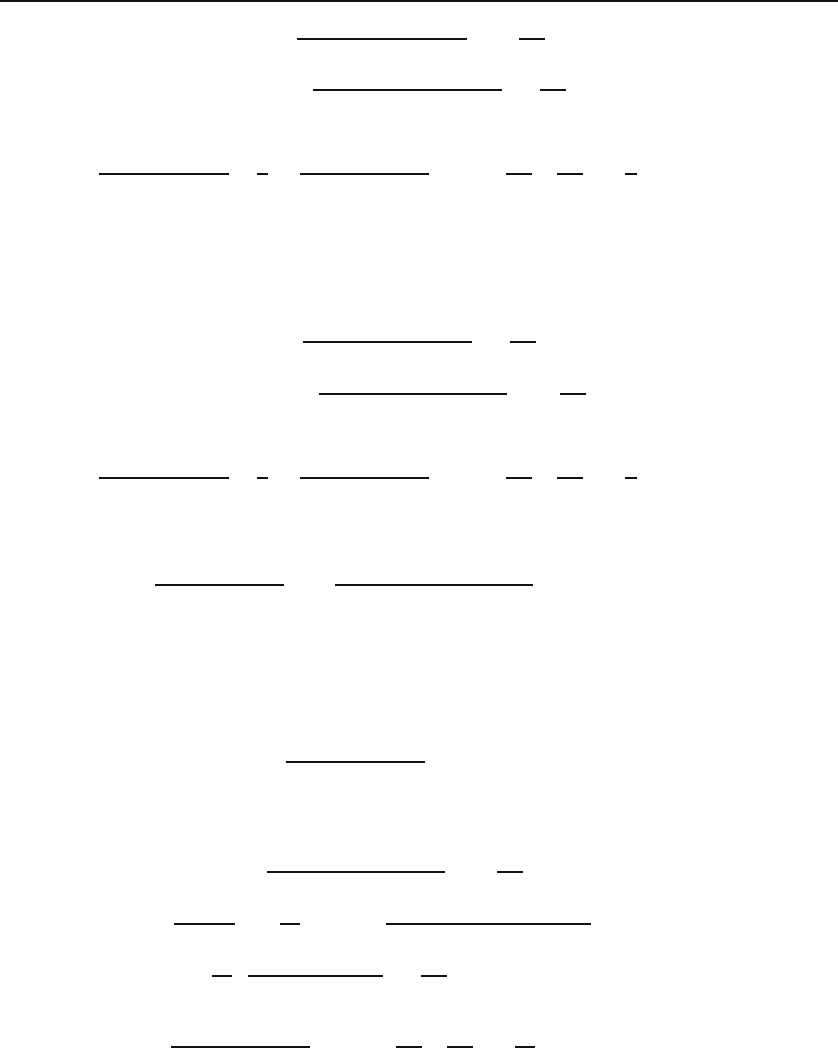
21.2 Integrals of Rational Functions 531
Res[f(i)] = lim
z→i
(z − i)
z
2
(z − i)(z + i)(z
2
+9)
= −
1
16i
,
Res[f(3i)] = lim
z→3i
(z −3i)
z
2
(z
2
+1)(z − 3i)(z +3i)
=
3
16i
.
Thus, we obtain
I =
#
∞
0
x
2
dx
(x
2
+1)(x
2
+9)
=
1
2
2
C
z
2
dz
(z
2
+1)(z
2
+9)
= πi
−
1
16i
+
3
16i
=
π
8
.
It is instructive to obtain the same results using the LHP. In this case the contour
is as shown in Figure 21.2(b). It is clear that the interior is to our right as we traverse
the contour. So we have to introduce a minus sign for its integration. The singular
points are at z = −i and z = −3i. These are simple poles at which the residues of
the function are
Res[f(−i)] = lim
z→−i
(z + i)
z
2
(z − i)(z + i)(z
2
+9)
=
1
16i
,
Res[f(−3i)] = lim
z→−3i
(z +3i)
z
2
(z
2
+1)(z − 3i)(z +3i)
= −
3
16i
.
Therefore,
I =
#
∞
0
x
2
dx
(x
2
+1)(x
2
+9)
=
1
2
2
C
z
2
dz
(z
2
+1)(z
2
+9)
= −πi
1
16i
−
3
16i
=
π
8
.
We now show that the integral of the large circle Γ tends to zero. On such a
circle, z = Re
iθ
; therefore
#
Γ
z
2
dz
(z
2
+1)(z
2
+9)
=
#
Γ
R
2
e
2iθ
Re
iθ
dθ
(R
2
e
2iθ
+1)(R
2
e
2iθ
+9)
.
In the limit that R →∞, we can ignore the small numbers 1 and 9 in the denom-
inator. Then the overall integral becomes 1/R times a finite integral over θ.It
follows that as R tends to infinity, the contribution of the large circle indeed goes to
zero.
Example 21.2.2. Let us now consider a more complicated integral:
#
∞
−∞
x
2
dx
(x
2
+1)(x
2
+4)
2
which turns into
E
C
z
2
dz/[(z
2
+1)(z
2
+4)
2
]. The poles in the UHP are at z = i and
z =2i. The former is a simple pole, and the latter is a pole of order 2. Thus,
Res[f(i)] = lim
z→i
(z −i)
z
2
(z −i)(z + i)(z
2
+4)
2
= −
1
18i
,
Res[f(2i)] =
1
(2 − 1)!
lim
z→2i
d
dz
(z − 2i)
2
z
2
(z
2
+1)(z +2i)
2
(z − 2i)
2
= lim
z→2i
d
dz
z
2
(z
2
+1)(z +2i)
2
=
5
72i
,
and
#
∞
−∞
x
2
dx
(x
2
+1)(x
2
+4)
2
=2πi
−
1
18i
+
5
72i
=
π
36
.
Closing the contour in the LHP would yield the same result as the reader is urged
to verify.

532 Calculus of Residues
21.3 Products of Rational and Trigonometric
Functions
The second type of integral we can evaluate using the residue theorem is of
the form
#
∞
−∞
p(x)
q(x)
cos ax dx or
#
∞
−∞
p(x)
q(x)
sin ax dx,
where a is a real number, p(x)andq(x) are real polynomials in x,andq(x)
has no real zeros. These integrals are the real and imaginary parts of
I
2
=
#
∞
−∞
p(x)
q(x)
e
iax
dx.
The presence of e
iax
dictates the choice of the half-plane: If a ≥ 0, we choose
the UHP because
e
iaz
= e
ia(x+iy)
= e
iax
e
−ay
where y>0,
and the negative exponent ensures convergence for large R and y. For the same
reason, we choose the LHP when a ≤ 0. The following examples illustrate the
procedure.
Example 21.3.1.
Let us evaluate
∞
−∞
cos ax dx/(x
2
+1)
2
where a =0. This
integral is the real part of the integral I
2
=
∞
−∞
e
iax
dx/(x
2
+1)
2
.Whena>0, we
close in the UHP. Then we proceed as for integrals of rational functions. Thus, we
have
I
2
=
2
C
e
iaz
(z
2
+1)
2
dz =2πiRes[f(i)] for a>0,
because there is only one singularity in the UHP at z = i which is a pole of order 2.
We next calculate the residue:
Res[f(i)] = lim
z→i
d
dz
(z − i)
2
e
iaz
(z −i)
2
(z + i)
2
= lim
z→i
d
dz
e
iaz
(z + i)
2
= lim
z→i
(z + i)iae
iaz
− 2e
iaz
(z + i)
3
=
e
−a
4i
(1 + a).
Substituting this in the expression for I
2
,weobtainI
2
=(π/2)e
−a
(1 + a)fora>0.
When a<0, we have to close the contour in the LHP, where the pole of order
2isatz = −i and the contour is taken clockwise. Thus, we get
I
2
=
2
C
e
iaz
(z
2
+1)
2
dz = −2πiRes[f(−i)] for a<0.
For the residue we obtain
Res[f(−i)] = lim
z→−i
d
dz
(z + i)
2
e
iaz
(z −i)
2
(z + i)
2
= −
e
a
4i
(1 − a)
and the expression for I
2
becomes I
2
=(π/2)e
a
(1 − a)fora<0. We can combine
the two results and write
#
∞
−∞
cos ax
(x
2
+1)
2
dx =Re(I
2
)=I
2
=
π
2
(1 + |a|)e
−|a|
.

21.3 Products of Rational and Trigonometric Functions 533
Example 21.3.2. As another example, let us evaluate
#
∞
−∞
x sin ax
x
4
+4
dx where a =0.
This is the imaginary part of the integral I
2
=
∞
−∞
xe
iax
dx/(x
4
+4) which, in terms
of z and for the closed contour in the UHP (when a>0), becomes
I
2
=
2
C
ze
iaz
z
4
+4
dz =2πi
m
j=1
Res[f(z
j
)] for a>0, (21.6)
where C is the large semicircle in the UHP. The singularities are determined by the
zeros of the denominator: z
4
+4=0 or z =1±i, −1 ±i. Of these four simple poles
only two, 1 + i and −1+i, are in the UHP. We now calculate the residues:
Res[f(1 + i)] = lim
z→1+i
(z −1 − i)
ze
iaz
(z −1 − i)(z − 1+i)(z +1− i)(z +1+i)
=
(1 + i)e
ia(1+i)
(2i)(2)(2 + 2i)
=
e
ia
e
−a
8i
,
Res[f(−1+i)] = lim
z→−1+i
(z +1− i)
ze
iaz
(z +1− i)(z +1+i)(z − 1 − i)(z − 1+i)
=
(−1+i)e
ia(−1+i)
(2i)(−2)(−2+2i)
= −
e
−ia
e
−a
8i
.
Substituting in Equation (21.6), we obtain
I
2
=2πi
e
−a
8i
(e
ia
− e
−ia
)=i
π
2
e
−a
sin a.
Thus,
#
∞
−∞
x sin ax
x
4
+4
dx =Im(I
2
)=
π
2
e
−a
sin a for a>0. (21.7)
For a<0, we could close the contour in the LHP. But there is an easier way of
getting to the answer. We note that −a>0, and Equation (21.7) yields
#
∞
−∞
x sin ax
x
4
+4
dx = −
#
∞
−∞
x sin[(− a)x]
x
4
+4
dx = −
π
2
e
−(−a)
sin(−a)=
π
2
e
a
sin a.
We can collect the two cases in
#
∞
−∞
x sin ax
x
4
+4
dx =
π
2
e
−|a|
sin a.
Example 21.3.3. The integral
∞
0
sin ax
x
dx occurs frequently in physics. To eval-
uate it, first we assume that a>0 and note that since the integrand is even, we can
extend the lower limit of integration to −∞ and write
#
∞
0
sin ax
x
dx =
1
2
#
∞
−∞
sin ax
x
dx.
As in the previous examples, we are inclined to choose the contour C in the UHP.
However, since C passes through the origin, this will not work because the origin is
the pole of the integrand. So, let’s avoid the origin by going around it on a small
